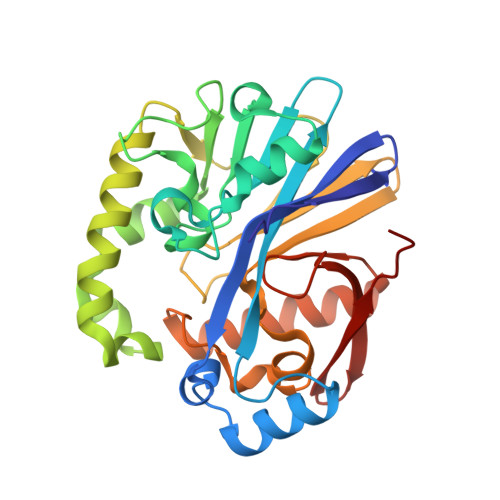Structural and Biochemical Characterization of AidC, a Quorum-Quenching Lactonase with Atypical Selectivity.
Mascarenhas, R., Thomas, P.W., Wu, C.X., Nocek, B.P., Hoang, Q.Q., Liu, D., Fast, W.(2015) Biochemistry 54: 4342-4353
- PubMed: 26115006
- DOI: https://doi.org/10.1021/acs.biochem.5b00499
- Primary Citation of Related Structures:
4ZO2, 4ZO3 - PubMed Abstract:
Quorum-quenching catalysts are of interest for potential application as biochemical tools for interrogating interbacterial communication pathways, as antibiofouling agents, and as anti-infective agents in plants and animals. Herein, the structure and function of AidC, an N-acyl-l-homoserine lactone (AHL) lactonase from Chryseobacterium, is characterized. Steady-state kinetics show that zinc-supplemented AidC is the most efficient wild-type quorum-quenching enzymes characterized to date, with a kcat/KM value of approximately 2 × 10(6) M(-1) s(-1) for N-heptanoyl-l-homoserine lactone. The enzyme has stricter substrate selectivity and significantly lower KM values (ca. 50 μM for preferred substrates) compared to those of typical AHL lactonases (ca. >1 mM). X-ray crystal structures of AidC alone and with the product N-hexanoyl-l-homoserine were determined at resolutions of 1.09 and 1.67 Å, respectively. Each structure displays as a dimer, and dimeric oligiomerization was also observed in solution by size-exclusion chromatography coupled with multiangle light scattering. The structures reveal two atypical features as compared to previously characterized AHL lactonases: a "kinked" α-helix that forms part of a closed binding pocket that provides affinity and enforces selectivity for AHL substrates and an active-site His substitution that is usually found in a homologous family of phosphodiesterases. Implications for the catalytic mechanism of AHL lactonases are discussed.
Organizational Affiliation:
§Department of Chemistry and Biochemistry, Loyola University Chicago, Chicago, Illinois 60660, United States.
















